Key words: Object tracking, Occlusion, Multiple patches, Weighted Vector Median Filter, Bhattacharyya Distance
Experimental results
Here, we presents some experimental results obtained with the proposed algorithm, called the Coherent Patch Displacement (CPD) Tracking algorithm [3]. The experimental validation was performed qualitatively, by visual inspection of tracking results, and also quantitatively, by comparing the tracking errors produced by the proposed approach and by two state-of-the-art techniques, namely the MeanShift algorithm [1] and the FragTrack algorithm [2].
All the results presented here were computed using C++ implementations of the algorithms (the code for FragTrack was kindly provided by Amit Adam), running on a PC computer with a Pentium Core 2 Duo 2.33GHz processor, 1GB RAM and windows XP operational system. To compare the techniques we used five different video sequences: Woman, Caviar, Face1, Face2, and Person. The Woman sequence is a video of a woman walking on a sidewalk, sometimes partially occluded by different cars (available for download at http://www.cs.technion.ac.il/˜amita/fragtrack/fragtrack.htm). The Caviar sequence is one of the videos of the CAVIAR project (http://homepages.inf.ed.ac.uk/rbf/CAVIAR), and it consists of some people walking through a mall. Face1 and Face2 are two facial video sequences, containing head tilts, turns and occlusions.
Finally, the Person video sequence illustrates a full body person moving behind several trees in an outdoor environment with illumination changes (from cloudy to partly sunny), shot with a moving camera. The Woman and Caviar video sequences are available with ground truth data, while the remaining sequences were manually ground truthed by our group.
For those five video sequences we computed the execution time and the tracking error (Euclidean distance between the actual position and the tracked position) for each frame. In all experiments, we used the same search region (30 × 30) for CPD Tracking and FragTrack (Meanshift does not require a search region). For Frag-Track, we used 16 histograms bins (only luminance information), and the EMD distance as the histogram matching procedure. For CPD Tracking, we used the same set of 5 features for all sequences: the 3 color channels and the 2 components of the gradient computed from the luminance component. It is important to emphasize that, although CPD presents other tunable parameters (sp, w, Tp, and c), the same default values described in the previous Section were used in all experiments. Clearly, even better results could be achieved by fine tuning those parameters to each individual video sequence.
We grant permission to use and publish all videos and numerical results generated by our group (namely, videos Face1, Face2 and Person), as long as reference [3] is cited.
Videos Results
| Woman | 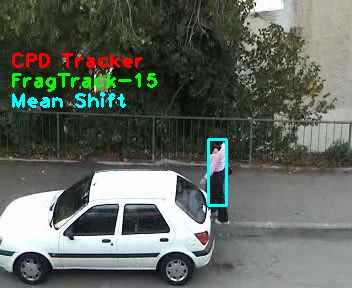 |
download (~1.7MB) |
| Caviar | 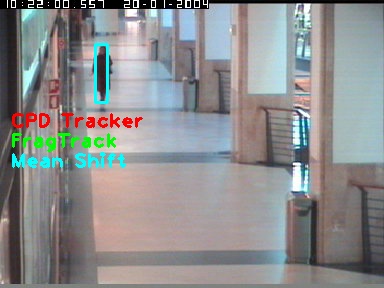 |
download (~1.3MB) |
| Face1 | 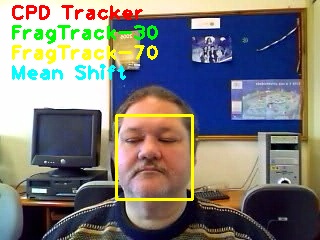 |
download (~1.7MB) |
| Face2 | 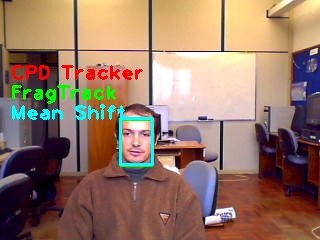 |
download (~1.6MB) |
| Person | 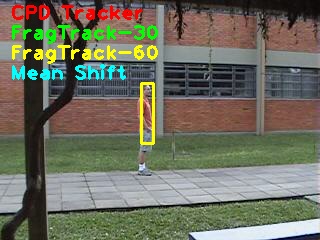 |
download (~4.1MB) |
Original sequences
| Face1 download (~1.7MB) |
Face2 download (~1.6MB) |
Person download (~4.1MB) |
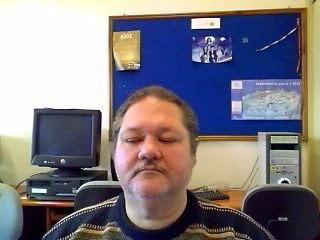 |
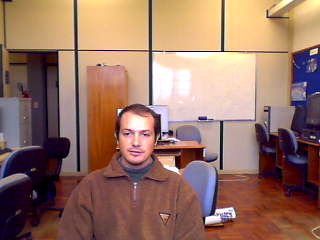 |
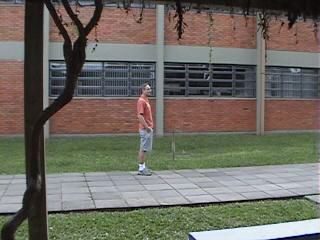 |
Ground truth
The Woman and Caviar video sequences are available with ground truth data, while the remaining sequences were manually ground truthed by our group.
| Face1 | Face2 | Person |
| download (~6K) | download (~7K) | download (~17K) |
[1] D. Comaniciu, V. Ramesh, P. Meer, Kernel-based object tracking, IEEE Transactions on Pattern Analysis and Machine Intelligence 25 (5) (2003) 564–577.
[2] A. Adam, E. Rivlin, I. Shimshoni, Robust fragments-based tracking using the integral histogram, in: Conference on Computer Vision and Pattern Recognition, IEEE Computer Society, Washington, DC, USA, 2006, pp. 798–805.
[3] DIHL, Leandro L. ; JUNG, Cláudio Rosito ; BINS, Jose C. . Robust Adaptive Patch-based Object Tracking using Weighted Vector Median Filters. In: SIBGRAPI, 2011, Maceio,. Conference on Graphics, Patterns and Images (SIBGRAPI), 2011. p. 149-156.
Back to Research
page